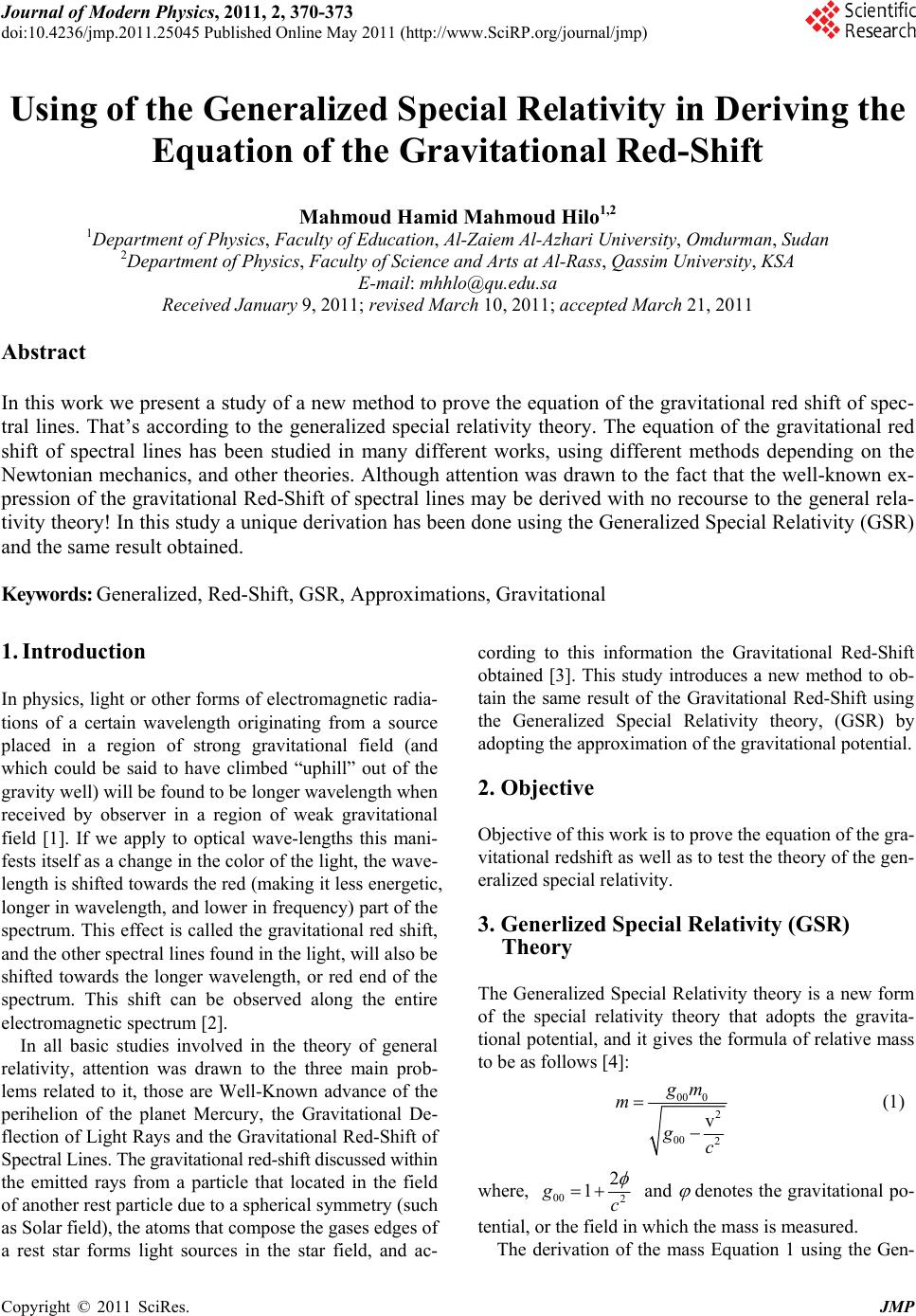
Journal of Modern Physics, 2011, 2, 370-373
doi:10.4236/jmp.2011.25045 Published Online May 2011 (http://www.SciRP.org/journal/jmp)
Copyright © 2011 SciRes. JMP
Using of the Generalized Special Relativity in Deriving the
Equation of the Gravitational Red-Shift
Mahmoud Hamid Mahmoud Hilo1,2
1Department of Physics, Faculty of Education, Al-Zaiem Al-Azhari University, Omdurman, Sudan
2Department of Physics, Faculty of Science and Arts at Al-Rass, Qassim University, KSA
E-mail: mhhlo@qu.edu.sa
Received January 9, 2011; revised March 10, 2011; accepted March 21, 2011
Abstract
In this work we present a study of a new method to prove the equation of the gravitational red shift of spec-
tral lines. That’s according to the generalized special relativity theory. The equation of the gravitational red
shift of spectral lines has been studied in many different works, using different methods depending on the
Newtonian mechanics, and other theories. Although attention was drawn to the fact that the well-known ex-
pression of the gravitational Red-Shift of spectral lines may be derived with no recourse to the general rela-
tivity theory! In this study a unique derivation has been done using the Generalized Special Relativity (GSR)
and the same result obtained.
Keywords: Generalized, Red-Shift, GSR, Approximations, Gravitational
1. Introduction
In physics, light or other forms of electromagnetic radia-
tions of a certain wavelength originating from a source
placed in a region of strong gravitational field (and
which could be said to have climbed “uphill” out of the
gravity well) will be found to be longer wavelength when
received by observer in a region of weak gravitational
field [1]. If we apply to optical wave-lengths this mani-
fests itself as a change in the color of the light, the wave-
length is shifted towards the red (making it less energetic,
longer in wavelength, and lower in frequency) part of the
spectrum. This effect is called the gravitational red shift,
and the other spectral lines found in the light, will also be
shifted towards the longer wavelength, or red end of the
spectrum. This shift can be observed along the entire
electromagnetic spectrum [2].
In all basic studies involved in the theory of general
relativity, attention was drawn to the three main prob-
lems related to it, those are Well-Known advance of the
perihelion of the planet Mercury, the Gravitational De-
flection of Light Rays and the Gravitational Red-Shift of
Spectral Lines. The gravitational red-shift discussed within
the emitted rays from a particle that located in the field
of another rest particle due to a spherical symmetry (such
as Solar field), the atoms that compose the gases edges of
a rest star forms light sources in the star field, and ac-
cording to this information the Gravitational Red-Shift
obtained [3]. This study introduces a new method to ob-
tain the same result of the Gravitational Red-Shift using
the Generalized Special Relativity theory, (GSR) by
adopting the approximation of the gravitational potential.
2. Objective
Objective of this work is to prove the equation of the gra-
vitational redshift as well as to test the theory of the gen-
eralized special relativity.
3. Generlized Special Relativity (GSR)
Theory
The Generalized Special Relativity theory is a new form
of the special relativity theory that adopts the gravita-
tional potential, and it gives the formula of relative mass
to be as follows [4]:
00 0
2
00 2
v
m
m
gc
(1)
where, 00 2
2
1gc
and
denotes the gravitational po-
tential, or the field in which the mass is measured.
The derivation of the mass Equation 1 using the Gen-